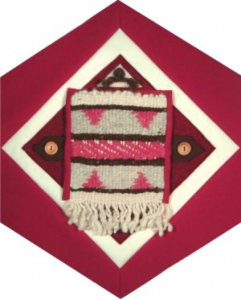Coast Salish

The Block
This block, created by weaver Myrna Crossley, is an example of an ancient Coast Salish art form, currently making a serious comeback. Taught by master weaver Rita Lewis, Myrna feels most connected to her cultural past as she dyes the wool and works it into a traditional design like that shown in the block. Here a miniature blanket is created in natural coloured and hand-dyed sheep’s wool, spun to the same size as would be used to make a full-sized blanket or garment. As this type of weaving is often used to create sweaters, the block has been embellished with wooden buttons and with one fringe left showing.
Cultural Profile
Although sources vary, the Coast Salish name is deemed to encompass several tribes, including the Comox, Sechelt(h), Sliammon, Hul’qumi’num, Homalco, Klahoose, Squamish and Tsleil Waututh, Halq’emeylem, Ostlq’emeylem, Pentlatch and Straits Salish (of which there are further divisions, such as, Lummi, Saanitch, Sooke and Songish, as well as subsidiary groups the Semiahmoo, Klallam and Samish). They all speak dialects within the Salishan linguistic group (a branch of the Algonquian-Wakashan family) and have similar cultural aspects.
An adaptable people, the Coast Salish are now the largest group of First Nations in British Columbia, having rebounded from the devastating affects of contact with Europeans, disease and death. They traditionally occupied and used the waterways of what is now southwest B.C. and the northwest United States. They lived in communal homes (up to 30 m long by 12 m wide) constructed of massive cedar logs and roof beams. Hand-split cedar boards were set parallel with the ground, between pairs of narrow poles and tied into place with twisted cedar branches to create walls. An example of this type of housing is in the Grand Hall of the Canadian Museum of Civilization. Figures carved on the interior houseposts are thought to represent powerful animals or ancestors.
The Salish are known for a distinctive method of grooving (or ‘kerfing’) a cedar plank, steaming it and bending it to create the sides of containers adapted to many uses, such as boxes and buckets. They made many other everyday tools and utensils from the cedar tree as well. Carved, ornamented bowls were used to serve delicacies at gatherings, canoes were created in many forms and sizes, and boat bailers and clothing made from fibres processed from the bark. The fibres were worked by hands covered in fish oil, effectively waterproofing the finished product. The fibres were woven by hand to create clothing, capes or rain hats.
Food was supplied by the abundant marine life: salmon and eulachon, cod, seals, sea lions and whales. Seaweed and shellfish were supplemented with a wide selection of berries, lupine, roots and hemlock bark.
Sponsor: Joyce & Jack McGaughey
